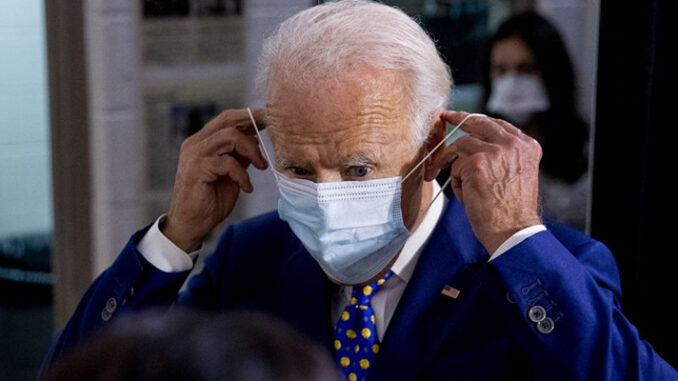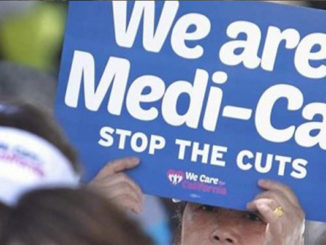
Executive power might be Biden’s best path to health care reform. Here’s what he could do.
Joe Biden has the opportunity to expand health coverage to more Americans through executive action as president, which might be his only option if the Senate remains under Republican control.
With an uphill battle ahead for Democrats to flip two Georgia Senate seats in early January and take control of the Senate, legislation to achieve universal health care probably won’t pass in the next few years. But that doesn’t mean Biden is powerless.
Biden could do a lot to cover more people, reduce their health care costs, and encourage states to be ambitious in their own health care programs without Congress. The most important question will be how big the Biden administration wants to go. Experts believe he could extend health coverage to a million people with a few strokes of the pen (and a comment period). States could also be interested in setting up their own public options, a pillar of Biden’s own health care plan, but it will be up to the federal government to set the rules under which they would operate.
“You watched Trump come in and push the envelope on executive authority. Biden is not really that guy, so I don’t know if that complicates things,” Katie Keith, a health law expert who writes for Health Affairs and teaches at Georgetown University, told me. “I think you’ve got to come out of the gate and show you’re doing something. I’m a little bit worried about half-measures that are hard to message around.”
Some of the administrative actions taken by President Donald Trump that undermined Obamacare’s insurance markets or restricted Medicaid coverage could be undone by a new Biden administration. There are also some obvious steps Biden could take to improve on the ACA, such as fixing the so-called “family glitch” that limits eligibility for premium subsidies for people who buy insurance on the law’s marketplaces.
But beyond that, Biden will have to decide how far he’s willing to stretch his executive authority to expand health coverage — and he’ll be dependent on states to take the lead. (His team is declining to comment for now on what specific actions they plan to take.)
The Obama administration was largely consumed with setting up the ACA. Biden’s first term will be the first chance Democrats have had to see how creative they can be under the law’s framework.
“I think a lot of people had the intuition that if Democrats take over the Congress and White House, the locus of power will move back to DC. But now it looks like that’s not going to happen,” Jason Levitis, who worked on health reform at the Obama Treasury Department, told me. “Anything that requires statutory change is going to be tough, so I think a lot of the action is going to stay at the state level.”
Undoing Trump’s health care actions won’t be as easy as it sounds
The biggest change from Trump to Biden will be substituting an administration that was actively hostile to the ACA with one that feels ownership over the law and wants to improve it. The US uninsured was already ticking up under Trump before the coronavirus pandemic struck and millions more people lost their health insurance.
Biden’s job will be to reverse those losses.
Some of what Trump did to undermine the health care law can be easily reversed. The Trump administration cut spending for Obamacare enrollment advertising and outreach deeply. But because those activities are funded by fees paid by insurance companies, that funding can probably be restored without any action by Congress, Keith said.
Beyond that, the Biden administration will have some difficult decisions to make about which Trump policies to reverse. Just as important, it will need to be diligent in its paperwork to avoid being roadblocked by a conservative judiciary.
There are specific rules that must be followed when producing federal regulations and guidance, which are laid out in laws like the Administrative Procedure Act (APA). Trump has run into trouble with that statute, with his health department’s plans to implement Medicaid work requirements initially stalled in the courts because they had violated the APA. The Supreme Court’s decision to block Trump’s reversal of Obama’s Deferred Action for Childhood Arrivals policy was another unforced error; the administration probably had the right to make that change, but by failing to offer an adequate justification for it, the Trump policy was disallowed.
“The Trump administration was particularly bad about following the rules,” Keith said. “I do expect to see a shift there, but that could mean things take a bit more time to do right.”
Another example: Joan Alker at the Georgetown University Center for Children and Families told me she expected Biden to quickly withdraw the Trump guidance that had encouraged states to propose Medicaid work requirements. But several Republican states have already had work requirements approved, with their legality currently pending before the Supreme Court.
The Biden administration will probably argue against work requirements if the Court takes the case. But if the justices rule the requirements are permissible and left to the discretion of the federal government, Biden’s officials will have to decide how to respond. They could try to withdraw the waiver, but they might first want to hold a hearing and a public comment period — all of which takes time and attention.
“The new administration will be very, very interested in figuring out how much of their agenda they can do administratively,” Aviva Aron-Dine, vice president for health policy at the Center on Budget and Policy Priorities, told me. “I really think it’s going to be more about: Each of these things is challenging, so where is senior-level bandwidth, focus and prioritization being put?”
There are also some Trump policies that Biden might simply want to keep.
Trump nixed funding that Obamacare is supposed to provide to health insurers, to cover out-of-pocket costs for low-income enrollees. But, unexpectedly, insurers and states found a way to work around that policy, called silver loading, and increased the tax subsidies that consumers received. (The short version: Insurers hike premiums only on the “benchmark” plans that are used to determine the size of the subsidy, in order to make up for the lost revenue, but keep premiums for other plans the same. Because the subsidy is now bigger, customers can afford a more generous health plan at a lower cost.)
So reversing that policy could actually end up increasing insurance premiums for people. At one time, Trump’s health department had threatened to crack down on silver loading. But Biden might instead decide to make it his formal policy, Aron-Dine said.
The most difficult decision for Biden will be on short-term limited-duration health plans. Trump greatly expanded those products, which are not subjected to Obamacare’s rules about preexisting conditions and benefits, by allowing them to last for a full year and be renewed for up to three years.
Biden and congressional Democrats have sharply criticized those “junk” plans. But canceling them without passing a bigger health care bill that would give people a new affordable option could be politically dangerous.
The Biden administration will probably be staffed with veterans from the Obama years who lived through the “if you like your plan, you can keep it” debacle. They may be hesitant to invite the same backlash again; about 3 million Americans are currently enrolled in a short-term plan.
“I will be annoyed if Democrats ran on junk plans and don’t do something,” Keith said. “But I think that’s absolutely a vulnerability.”
One big thing Biden may do to expand health coverage: Fix the family glitch
Every center-left health policy expert I spoke with flagged one administrative action that Biden could take that would extend health coverage to a million people or more: fixing the “family glitch” in the Affordable Care Act.
“One of the most important things is fixing the family glitch,” Sabrina Corlette with the Georgetown Center on Health Insurance Reforms told me. “That I think they could do.”
In brief: Somewhere between 2 million and 6 million Americans have been deemed ineligible for premium subsidies that would help them purchase an Obamacare insurance plan because of an Obama-era regulation.
The ACA doesn’t allow a person to qualify for premium subsidies if they have an offer of affordable health insurance from their employer. The IRS under Obama concluded that the family members of the person who gets employer-sponsored coverage also don’t qualify for subsidies, even if an employer plan would be much more expensive for the family members than it is for the worker, as is often the case.
As Louise Norris wrote for HealthInsurance.org, as many as 6 million people have been affected, and they are disproportionately low-income.
Democrats have proposed fixing the family glitch through legislation, though that seems unlikely if Republicans control the Senate. But left-leaning policy and legal experts believe a Biden administration could simply rewrite the IRS regulation that created the glitch and make those people eligible for coverage.
A Congressional Budget Office analysis of a Senate bill to make the same change estimated the plan would cover between 700,000 and 1.5 million currently uninsured people. It would also cost the feds between $4 billion and $9 billion.
Because it was the Obama administration that created the glitch in the first place and many Obama veterans are expected to staff Biden’s team, fixing the family glitch isn’t assured. But the hope is they will see the opportunity to use executive power to right a previous wrong.
“I hope they feel a little more emboldened,” Keith said.
Biden has wonky decisions to make, with major consequences for his agenda
There is a long wish list of other administrative changes Biden could make to improve health coverage. He could ease federal rules about taking back money from people who are found to have received too big a subsidy when they file their taxes. He could increase the oversight of private insurance brokers. A Biden administration could establish a special enrollment period for people to sign up for ACA coverage, which Trump has refused to do during the Covid-19 pandemic.
But the most likely venue for innovation that could insure more people would be a state waiver program created by Obamacare known as 1332.
To date, the use of 1332s has been limited, primarily being used by states to start reinsurance programs to reduce premiums. But the potential under the program is pretty expansive. When Vermont considered setting up a single-payer health care plan, it was a 1332 waiver that would have given the state that authority.
“We haven’t seen what it can do under a Democratic administration with eager states,” Levitis, who now works with states on developing their 1332 waiver plans, said.
The rules for the waivers are generally quite broad. States can do almost anything they want, as long as their plan doesn’t cost the federal government more money than regular Obamacare does and as long as it does not lead to fewer people having health insurance.
But the devil is, as always, in the details.
A 1332 waiver is supposed to be budget-neutral. Both the Obama and Trump administrations have interpreted that requirement very strictly to mean that every single year of the waiver program must cost the federal government less money than Obamacare would.
“That is the key limiter of what more progressive states want to do,” Levitis said. “You’ve heard complaints from states.”
But a Biden administration could conceivably take a looser interpretation of budget neutrality. Maybe, to float one example, the program only needs to be budget-neutral by the end of a 10-year window, but could run deficits in the earlier years of the program. While the new president might not want to be seen as a big-spending Democrat, based on some comments from his close advisers, this more flexible approach may be what is necessary to achieve substantive change without any cooperation from Congress.
States have big ideas for what they could propose under a 1332 waiver with the Biden administration in power: a public option, or provider rate-setting, or various proposals to cut drug costs. They may be able to do some of them no matter what rules Biden adopts on budget neutrality: A public option will probably pay lower rates than a commercial health plan and could therefore save the government money. But that work would be made easier by a malleable approach to accounting.
So, as wonky as it sounds, the 1332 waiver guidance adopted under the Biden administration will be an early signal of what kind of health department the new president plans to run.
“I do think that’s the $64,000 question,” Levitis told me. “Until you loosen that, it’s going to be tough for a state to use 1332 for a big coverage expansion.”
Dylan Scott is a Policy Reporter for Vox.



